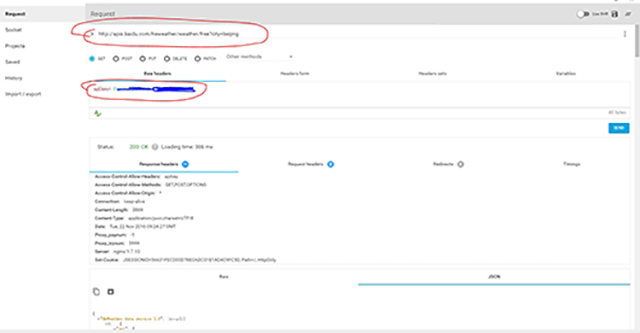Introduction
In this article, I will introduce how to call RESTful API in servlet.
Background
Assume that we need to search and show the weather condition of the specified city. There are a lot of third web services on the internet. I am using Baidu Weather web service to demonstrate this. Now, let's get started with the following steps.
Using the Code
- Go to the website where you choose to use the web service, and register an account and get an apikey for you.
- Find and understand the API description. Take Baidu for example.
- API Address: http://apis.baidu.com/heweather/weather/free
- Request Method:
GET - Request Parameter in Header:
| Name
| Type
| Required
| location
| Description
| Default Value
|
| apikey
| string
| yes
| header
| APIkey from your web service provider for you
| apikey
|
- Url Parameter:
| Name
| Type
| Required
| location
| Description
| Default Value
|
| city
| string
| yes
| urlParam
| city name
| beijing
|
- Result in Json:
"HeWeather data service 3.0": [
{
"status": "ok",
"basic": {
"city": "Beijing",
"cnty": "China",
"id": "CN101010100",
"lat": "39.904000",
"lon": "116.391000",
"update": {
"loc": "2015-07-02 14:44",
"utc": "2015-07-02 06:46"
}
},
"now": {
"cond": {
"code": "100",
"txt": "sunny day"
},
,......
}
]
}
- For the sake of test REST API easily. Please find or install some tools on your computer, such as restclient, fiddler and so on. If you are using Chrome or Firefox browser, you can also install REST client add-in. I installed Advanced REST Client on my Chrome browser.
- Launch the rest client. Please input API address and apikey like the below picture, and click Send button. You will get a json
string result.

- Launch http://www.jsonschema2pojo.org/ and copy the json string result and paste it in the page to generate the javabean classes. Then download the zip and unpack them to your project folder after you create a dynamic Web Project in Eclipse.

- When you open your project with Eclipse, you will see the following image:

- Create a new package for services such as com.BaiduWeather.Services. Here the proxy to call RESTfull API locate. Add a class named BaiduWeatherService.java and the code lines as below in it.
Notice:
- Before this, you should download the gson-2.8.0.jar from Gson Download at Maven Central, copy it to the folder WebContent/WEB-INF/lib/gson-2.8.0.jar and add it to Java Build Path.
- Remember to change the apiKey with yours.
package com.BaiduWeather.Services;
import java.io.BufferedReader;
import java.io.IOException;
import java.io.InputStreamReader;
import java.io.UnsupportedEncodingException;
import java.net.HttpURLConnection;
import java.net.MalformedURLException;
import java.net.URL;
import java.net.URLEncoder;
import com.BaiduWeather.Entities.Root;
import com.google.gson.Gson;
import com.google.gson.GsonBuilder;
import com.google.gson.JsonSyntaxException;
public class BaiduWeatherService {
private static final String apiKey="0ae09eed4f3c024451ads12d1gsgsg1sg";
private static final String baseBaiduUrl=
"http://apis.baidu.com/heweather/weather/free?city=";
public static Root getWeatherInfo(String cityName)
{
String jsonResult=getWeatherJsonString(cityName);
Root weatherInfoObject=toEntity(jsonResult);
return weatherInfoObject;
}
private static Root toEntity(String jsonString)
{
try{
Gson gson = new GsonBuilder().create();
Root weatherInfo = gson.fromJson(jsonString, Root.class);
return weatherInfo;
}
catch(JsonSyntaxException ex)
{
ex.printStackTrace();
return null;
}
}
private static String getWeatherJsonString(String cityName) throws RuntimeException{
String baiduUrl = baseBaiduUrl+"beijing";
try {
if(cityName!=null && cityName!="")
baiduUrl = baseBaiduUrl+URLEncoder.encode(cityName, "utf-8");
} catch (UnsupportedEncodingException e1) {
e1.printStackTrace();
}
StringBuilder strBuf = new StringBuilder();
HttpURLConnection conn=null;
BufferedReader reader=null;
try{
URL url = new URL(baiduUrl);
conn = (HttpURLConnection)url.openConnection();
conn.setRequestMethod("GET");
conn.setRequestProperty("Accept", "application/json");
conn.setRequestProperty("apikey",apiKey);
if (conn.getResponseCode() != 200) {
throw new RuntimeException("HTTP GET Request Failed with Error code : "
+ conn.getResponseCode());
}
reader = new BufferedReader(new InputStreamReader(conn.getInputStream(),"utf-8"));
String output = null;
while ((output = reader.readLine()) != null)
strBuf.append(output);
}catch(MalformedURLException e) {
e.printStackTrace();
}catch(IOException e){
e.printStackTrace();
}
finally
{
if(reader!=null)
{
try {
reader.close();
} catch (IOException e) {
e.printStackTrace();
}
}
if(conn!=null)
{
conn.disconnect();
}
}
return strBuf.toString();
}
}
- Create a new package
com.BaiduWeather.Servlets and a new class WeatherServlet.java under it. Add the following code lines in this Java file:
package com.BaiduWeather.Servlets;
import java.io.IOException;
import java.util.List;
import javax.servlet.ServletException;
import javax.servlet.annotation.WebServlet;
import javax.servlet.http.HttpServlet;
import javax.servlet.http.HttpServletRequest;
import javax.servlet.http.HttpServletResponse;
import com.BaiduWeather.Entities.HeWeatherDataService30;
import com.BaiduWeather.Entities.Root;
import com.BaiduWeather.Services.BaiduWeatherService;
@WebServlet("/weather")
public class WeatherServlet extends HttpServlet {
private static final long serialVersionUID = 1L;
public WeatherServlet() {
super();
}
protected void doGet(HttpServletRequest request, HttpServletResponse response)
throws ServletException, IOException {
String city=request.getParameter("city");
Root wheatherInfoObject=BaiduWeatherService.getWeatherInfo(city);
if(wheatherInfoObject!=null){
List<HeWeatherDataService30> weatherlist= wheatherInfoObject.getHeWeatherDataService30();
if(weatherlist!=null)
{
StringBuilder outputContent=new StringBuilder();
outputContent.append("<!DOCTYPE html><html><head><meta charset=\"UTF-8\">
<title>Insert title here</title></head><body><form action=\"weather\"
method=\"GET\"><select name=\"city\"><option value =\"beijing\">北京</option>
<option value =\"shanghai\">上海</option><option value =\"xian\">西安</option>
</select><input type=\"submit\" value=\"Submit\"></form>");
outputContent.append(weatherlist.get(0).getBasic().getCity());
outputContent.append("<br/>");
outputContent.append(weatherlist.get(0).getNow().getTmp());
outputContent.append("℃");
outputContent.append("<br/>");
outputContent.append(weatherlist.get(0).getNow().getCond().getTxt());
outputContent.append("<br/>");
outputContent.append(weatherlist.get(0).getNow().getWind().getDir());
outputContent.append("</body></html>");
response.setContentType("text/html; charset=utf-8");
response.getWriter().write(outputContent.toString());
}
}
}
protected void doPost(HttpServletRequest request, HttpServletResponse response)
throws ServletException, IOException {
doGet(request, response);
}
}
- In WebContent/WEB-INF/web.xml, add the following configuration items.
="1.0"="UTF-8"
<web-app xmlns:xsi="http://www.w3.org/2001/XMLSchema-instance"
xmlns="http://xmlns.jcp.org/xml/ns/javaee"
xsi:schemaLocation="http://xmlns.jcp.org/xml/ns/javaee http://xmlns.jcp.org/xml/ns/javaee/web-app_3_1.xsd"
id="WebApp_ID" version="3.1">
<display-name>BaiduWeather</display-name>
<welcome-file-list>
<welcome-file>index.htm</welcome-file>
<welcome-file>index.jsp</welcome-file>
<welcome-file>default.html</welcome-file>
<welcome-file>default.htm</welcome-file>
<welcome-file>default.jsp</welcome-file>
<welcome-file>weather</welcome-file>
</welcome-file-list>
<servlet>
<servlet-name>WeatherServlet</servlet-name>
<servlet-class>com.BaiduWeather.Servlets.WeatherServlet</servlet-class>
</servlet>
<servlet-mapping>
<servlet-name>WeatherServlet</servlet-name>
<url-pattern>/BaiduWeather/weather</url-pattern>
</servlet-mapping>
</web-app>
- Run and debug this servlet, you should get weather information on an HTML page.

Thanks for reading!
